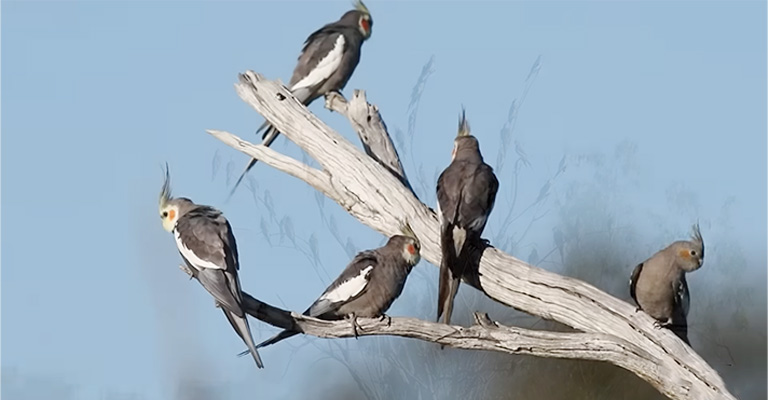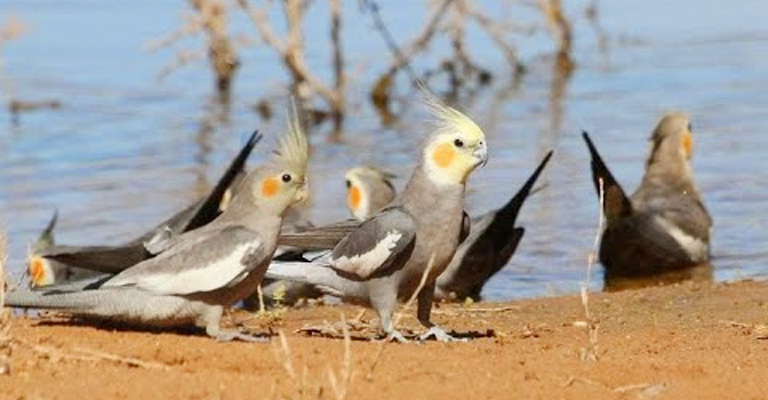Cockatiels, those charming and charismatic parrots, have captured the hearts of bird enthusiasts worldwide. But have you ever wondered where do cockatiels live in the wild and why?
In this exploration, we delve into the natural habitat of cockatiels, uncovering the intriguing reasons behind their choice of residence. Nestled within the heart of Australia, the cockatiel’s native habitat offers a captivating blend of wilderness and beauty.
From the arid expanses of the Outback to the lush coastal regions, these birds have adapted to a variety of landscapes. Their preference for certain environments, such as eucalyptus woodlands and savannas, is a testament to their remarkable ability to thrive in diverse conditions.
Join us as we embark on a journey to discover where cockatiels live in the wild and gain insight into the ecological factors that influence their choice of habitat. Understanding their natural environment is key to appreciating and conserving these feathered treasures.

Where Do Cockatiels Live in the Wild and Why?
Cockatiels (Nymphicus hollandicus) are charming and popular pet birds, but they also have a natural habitat in the wild. These birds are native to Australia, and they primarily inhabit various regions across the continent.
To provide a comprehensive understanding of where cockatiels live in the wild and why, let’s delve into the details.
Natural Range and Distribution
Cockatiels are endemic to Australia, meaning they are found nowhere else in the wild. Their natural range spans across the eastern and southern parts of the continent.
Specifically, they can be found in regions such as Queensland, New South Wales, Northern Territory, and South Australia. Their habitat can range from arid and semi-arid areas to densely wooded regions.
Habitat Preferences
In the wild, cockatiels display remarkable adaptability when it comes to their habitat preferences. They are often found in a variety of environments, and this adaptability has contributed to their widespread distribution.
Open Woodlands
Cockatiels are commonly found in open woodlands, particularly those with eucalyptus trees. These trees provide not only shelter but also a valuable source of food in the form of seeds and foliage. The open nature of woodlands allows cockatiels to navigate and forage for food effectively.
Grasslands
In some regions, cockatiels inhabit grasslands and savannahs. Here, they can find grass seeds and other plant materials to supplement their diet. These areas might not offer as much natural shelter, so cockatiels rely on their adaptability to find suitable resting spots.
Riparian Zones
Along riverbanks and near water bodies, cockatiels are known to make their homes. The availability of water is a critical factor, and these areas often provide a richer variety of vegetation and food sources.
Arid Regions
Cockatiels are also found in arid and semi-arid regions, where water can be scarce. They have evolved to withstand such conditions, often relying on their ability to extract moisture from the seeds they consume.
Human-Altered Environments
Cockatiels are not shy about venturing into areas impacted by human activity. They can be spotted in farmlands, urban parks, and even suburban neighborhoods, displaying their adaptability to changing landscapes.
The Importance of Habitat

Understanding why cockatiels live in these various habitats in the wild requires a consideration of their ecological niche and the resources they rely on.
Food Sources
Cockatiels primarily feed on seeds, including those from grasses and various plant species. Their natural habitats provide a diverse array of seed-bearing plants, making it easier for them to find sustenance. Eucalyptus trees, in particular, are a valuable source of both food and shelter.
Water Availability
As with any species, access to water is crucial for cockatiels. This is especially true in arid regions, where they have developed adaptations to minimize water loss. Choosing habitats near water bodies or in regions with periodic rainfall helps them meet their hydration needs.
Shelter and Nesting Sites
Cockatiels are cavity nesters, which means they seek shelter in hollows or crevices. Trees in woodlands and riparian zones often provide ideal nesting sites. Additionally, these habitats offer protection from predators, which is essential for their survival.
Safety and Camouflage
Open woodlands and grasslands allow cockatiels to blend into their surroundings and evade predators more effectively. Their gray and yellow plumage provides camouflage in these environments, helping them stay hidden.
Social Structure
Cockatiels are social birds and often live in flocks. Their choice of habitat should ideally support the needs of a group, including access to food, water, and suitable nesting sites.
Challenges and Conservation
While cockatiels have demonstrated adaptability to various habitats, they face challenges in the wild, primarily due to habitat loss and fragmentation caused by human activities such as urbanization and agriculture.
These alterations to their natural habitat can disrupt their foraging patterns, nesting sites, and access to water sources.
Conservation efforts are essential to ensure the continued survival of cockatiels in the wild. This includes habitat protection and restoration, as well as measures to mitigate the impact of invasive species and climate change.
By preserving their natural habitats, we can help maintain the ecological balance and biodiversity of the regions where these charismatic birds call home.
What Do Cockatiels Eat in the Wild?

Cockatiels are charming and resourceful birds in the wild, and their diet plays a critical role in their survival and well-being. Their natural habitat in Australia provides them with a diverse range of food sources.
In this exploration, we’ll delve into what cockatiels eat in the wild and how they obtain their nutrition.
Seeds
Seeds are a staple in the diet of wild cockatiels. They are particularly fond of the seeds from various plant species that are commonly found in their natural habitat. Eucalyptus trees, in particular, are a favored source of seeds for cockatiels.
They feed on the seeds produced by different species of eucalyptus trees, such as the River Red Gum (Eucalyptus camaldulensis) and the Yellow Gum (Eucalyptus leucoxylon).
In addition to eucalyptus seeds, cockatiels consume a variety of other seeds from native grasses and plants. These seeds are rich in nutrients and provide the necessary energy for their daily activities, including foraging and flying.
Foliage
Cockatiels are not solely seed-eaters; they also incorporate foliage into their diet. While seeds are their primary source of sustenance, they nibble on leaves and plant shoots.
This behavior is often seen during breeding season when they may require additional nutrients to support the growth of their chicks.
The consumption of foliage provides supplementary vitamins and minerals that might be lacking in their seed-based diet. It also helps them stay hydrated, as leaves contain moisture, which can be beneficial in arid regions.
Water
While wild cockatiels obtain some moisture from the plants they consume, they also need a separate source of water to stay hydrated. Therefore, they are often found near water bodies, such as rivers, streams, and waterholes.
These locations provide them with a readily available source of water, which is essential for their survival, especially in arid regions where water can be scarce.
Insects and Invertebrates
Cockatiels are opportunistic feeders, and on occasion, they supplement their diet with insects and invertebrates. Insects such as grasshoppers, caterpillars, and ants are sources of protein and other essential nutrients.
They may also consume small invertebrates like spiders. This behavior is particularly common during the breeding season when adult cockatiels require a protein-rich diet to feed their growing chicks.
Insects and invertebrates can be an important food source for both adult and juvenile cockatiels during this period.
Human-Provided Food
In regions where cockatiels overlap with human settlements, they may opportunistically consume human-provided food, such as grains, bread, and fruits.
While these items are not part of their natural diet, their adaptability allows them to make use of available resources when necessary. However, a diet high in human-provided food is not ideal for their long-term health and well-being.
Seasonal Variation
Cockatiels’ dietary preferences can vary with the seasons. During periods of food scarcity, such as droughts, they may become more reliant on certain food sources, such as seeds from eucalyptus trees, to sustain themselves.
Conversely, in times of plenty, when plants are flowering and seeds are abundant, they may have a more varied diet.
FAQs
Are wild cockatiels social birds?
Yes, wild cockatiels are social birds and often live in flocks. They exhibit social behaviors within these groups, which can include foraging together, grooming each other, and engaging in communal activities.
Being part of a flock provides safety and enhances their chances of finding food.
Do wild cockatiels build nests?
Yes, wild cockatiels are cavity nesters. They seek shelter in hollows or crevices, often within trees in their natural habitat. These nests provide protection for their eggs and chicks from predators and environmental factors.
Are wild cockatiels endangered or threatened?
Wild cockatiels were not considered endangered or threatened. However, their populations can be affected by habitat loss due to urbanization and agriculture. Conservation efforts are essential to ensure the continued survival of these birds in their native habitats.
What should I feed my pet cockatiel?
A balanced diet for a pet cockatiel should include a high-quality pellet mix, supplemented with fresh fruits and vegetables. Seeds can be given in moderation but should not be the primary diet as they are high in fat. Providing clean, fresh water is essential.
Are cockatiels good pets for beginners?
Cockatiels are often considered good pets for beginners in the world of avian companions. They are relatively small, have friendly personalities, and can learn to mimic simple tunes. However, they still require proper care, attention, and socialization.
Conclusion
The cockatiel’s natural habitat is a testament to their adaptability and resilience as a species. Their choice of residence in the vast Australian landscape reflects their ability to thrive in diverse environments, from arid deserts to flourishing woodlands.
This adaptability has allowed them to become one of the most beloved parrot species globally. As we’ve explored the reasons behind their habitat choices, we’ve gained a deeper appreciation for the ecological factors that influence their lives.
It’s crucial to recognize the importance of preserving these habitats to ensure the continued well-being of wild cockatiel populations.
Whether you’re a passionate bird enthusiast or simply curious about the world these enchanting birds come from, understanding where cockatiels live in the wild enriches our connection with these magnificent creatures.
So, let us continue to admire and protect their natural homes, ensuring that future generations can marvel at the beauty of cockatiels in their wild and wonderful environments.